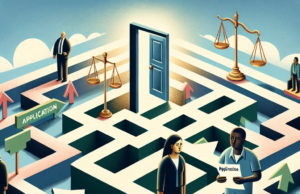Unveiling the Crisis: The Alarming State of Border Security Measures

In an era marked by increasing global mobility and complex geopolitical dynamics, the state of border security has emerged as a pressing concern for nations worldwide. The challenges associated with safeguarding borders are multifaceted, encompassing issues of immigration, human trafficking, drug smuggling, and national security. As governments grapple with these challenges, it is imperative to understand the current landscape of border security, the historical context that has shaped it, and the key factors contributing to its deterioration. This article aims to provide a comprehensive analysis of these issues, while also exploring the role of technology and offering policy recommendations for strengthening border security measures.
Understanding the Current Landscape of Border Security: An Overview of Challenges
The contemporary landscape of border security is characterized by a myriad of challenges that threaten the integrity and safety of national borders. Increased migration flows, driven by conflict, economic instability, and climate change, have put immense pressure on border control systems. Additionally, the rise of transnational crime networks has complicated enforcement efforts, as these organizations exploit vulnerabilities in border security to facilitate drug trafficking, human smuggling, and terrorism. The COVID-19 pandemic further exacerbated these challenges, as countries implemented varying degrees of travel restrictions, leading to confusion and gaps in enforcement. As a result, many nations find themselves at a crossroads, struggling to balance humanitarian obligations with the need for robust security measures.
Historical Context: How Border Security Measures Have Evolved Over the Decades
Border security measures have undergone significant transformations over the decades, shaped by historical events, technological advancements, and shifting political landscapes. In the post-World War II era, borders were often viewed as lines of demarcation that facilitated trade and movement. However, the Cold War introduced a new paradigm, where borders became fortified barriers against perceived ideological threats. The events of September 11, 2001, marked a watershed moment in border security, leading to the implementation of stringent measures aimed at preventing terrorism. The establishment of agencies such as the Department of Homeland Security in the United States exemplified this shift. In recent years, the rise of globalization and digital technology has further complicated border security, necessitating a reevaluation of existing measures to address contemporary threats.
Key Factors Contributing to the Deterioration of Border Security Today
Several key factors have contributed to the deterioration of border security in recent years. First and foremost, the increasing volume of cross-border traffic, both legal and illegal, has overwhelmed existing security infrastructure. Many border agencies are underfunded and understaffed, leading to gaps in surveillance and enforcement capabilities. Additionally, political polarization surrounding immigration policies has hindered bipartisan support for comprehensive border security reforms. The rise of populist movements in various countries has also led to a backlash against globalization, resulting in inconsistent and often reactionary border policies. Furthermore, the proliferation of misinformation and disinformation campaigns has complicated public perception of border security, making it challenging for policymakers to implement effective strategies.
The Role of Technology in Enhancing or Compromising Border Security Efforts
Technology plays a dual role in the realm of border security, serving both as a tool for enhancement and a potential compromise. On one hand, advancements in surveillance technology, such as drones, biometric identification systems, and artificial intelligence, have significantly improved the ability of border agencies to monitor and respond to threats. These technologies enable real-time data analysis and facilitate more efficient resource allocation. On the other hand, the same technologies can be exploited by criminal organizations to circumvent security measures. Cybersecurity threats pose an additional challenge, as border security systems become increasingly reliant on digital infrastructure. As nations invest in technological solutions, it is crucial to strike a balance between leveraging innovation and safeguarding against potential vulnerabilities.
Case Studies: Analyzing Recent Incidents Highlighting Border Security Failures
Recent incidents have underscored the vulnerabilities within border security systems, prompting urgent calls for reform. For instance, the surge of migrants at the U.S.-Mexico border in 2021 revealed significant gaps in processing capabilities and resource allocation, leading to overcrowded facilities and humanitarian crises. Similarly, the tragic drowning of migrants attempting to cross the English Channel highlighted the dangers posed by human trafficking networks that exploit weak border enforcement. In Europe, the ongoing refugee crisis has exposed the limitations of the Schengen Agreement, as member states grapple with the challenges of managing external borders while upholding the principles of free movement. These case studies illustrate the urgent need for comprehensive assessments of border security measures and the implementation of effective strategies to address identified weaknesses.
Policy Recommendations: Strategies for Strengthening Border Security Measures Moving Forward
To strengthen border security measures moving forward, a multifaceted approach is essential. First, governments should prioritize investment in border infrastructure, ensuring that agencies are adequately funded and staffed to handle increasing traffic. Comprehensive training programs for border personnel can enhance their ability to respond to emerging threats effectively. Additionally, fostering international cooperation and information sharing among nations can facilitate a more coordinated response to transnational crime and migration challenges. Policymakers should also consider adopting a balanced approach to immigration that addresses humanitarian concerns while maintaining security. Finally, leveraging technology responsibly, with a focus on cybersecurity and ethical considerations, will be crucial in enhancing border security without compromising individual rights.
The alarming state of border security measures demands immediate attention and action from governments worldwide. As the challenges associated with border security continue to evolve, it is imperative to adopt a proactive and comprehensive approach that addresses both security and humanitarian concerns. By understanding the current landscape, learning from historical context, and implementing strategic policy recommendations, nations can work towards a more secure and effective border management system that meets the needs of an increasingly interconnected world.























